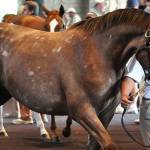Pastern Abnormalities and Future Soundness in High-Performance Horses

An osteochondral defect in a weight-bearing joint in a young horse often makes owners and potential buyers pause, leaving them wondering if the horse will hold up to the physical pressures of training. A review of yearling radiographs suggested that there is a “low to moderate risk to future racing performance” when such lesions are found in the proximal interphalangeal (PIP) joint.*
Compared to other joints, like the hock and the stifle, little information is available regarding the prevalence of osteochondral abnormalities in the PIP. This joint is located between the two pastern bones, involving the low end of the first phalanx (the long pastern bone) and the high end of the second phalanx (the short pastern bone).
To determine if PIP joint abnormalities negatively affect Thoroughbred racehorses, 1,098 repository sales radiographs were reviewed. Horses with lesions were placed in one of two categories: (1) abnormal subchondral bone (the layer of bone immediately beneath the cartilage that lines the joints), or (2) osteochondral fragmentation involving the joint surface. The sales prices of those horses and their subsequent racing performances were reviewed. For reference, specific sales and performance metrics were compared with maternal siblings as well as healthy horses sold as yearlings with available repository radiographs and healthy PIP joints.
The prevalence of PIP abnormalities was 6.3%, higher than previous studies reporting lesions of the same joint. Most of those horses (4.8%) had subchondral lucencies (SCLs)—areas where the bone underlying the articular cartilage did not form properly—at the end of the first phalanx. Some SCLs were described as cysts and primarily occurred in the forelimbs. SCLs of the second phalanx and osteochondral chip fractures/fragments were far less common (0.6% and 0.8%, respectively), primarily recognized in the hind limbs.
Overall, no noteworthy statistical differences in sales price and performance were observed in the study, except for the chip fractures. Fewer horses with osteochondral fragments of the PIP were sold. But when the horses were sold, their sales prices were comparable to control groups. Further, no significant difference in racing performance was measured between horses with PIP lesions compared with the two control groups.
“The etiology of SCLs and osteochondral fragmentation is thought to be multifactorial and can be developmental or traumatic in origin. A failure of the blood supply to the epiphyseal growth cartilage is considered a key factor in the development of lesions. Various studies have implicated heavy young horses (for their age and sex) and rapid growth in height or weight as risk factors for development of osteochondrosis,” explained Peter Huntington, B.V.Sc., M.A.C.V.Sc., director of nutrition for Kentucky Equine Research in Australia
He added, “To help manage young, growing horses, Kentucky Equine Research created the world’s first equine growth management software, Gro-Trac. This can be used by breeders to monitor weight and growth to facilitate management changes that reduce the risk of developmental orthopedic disorders, such as bone cysts, that may negatively affect the future performance of a horse.”
*Faulkner, J., K. Vanderperren, L. Duchateau, and C. O’Sullivan. 2022. Radiographic prevalence of juvenile osteochondral conditions of the proximal interphalangeal joint of Australian Thoroughbred racehorse yearlings and associations with sales results and race performance. Frontiers in Veterinary Science 9:988826.








